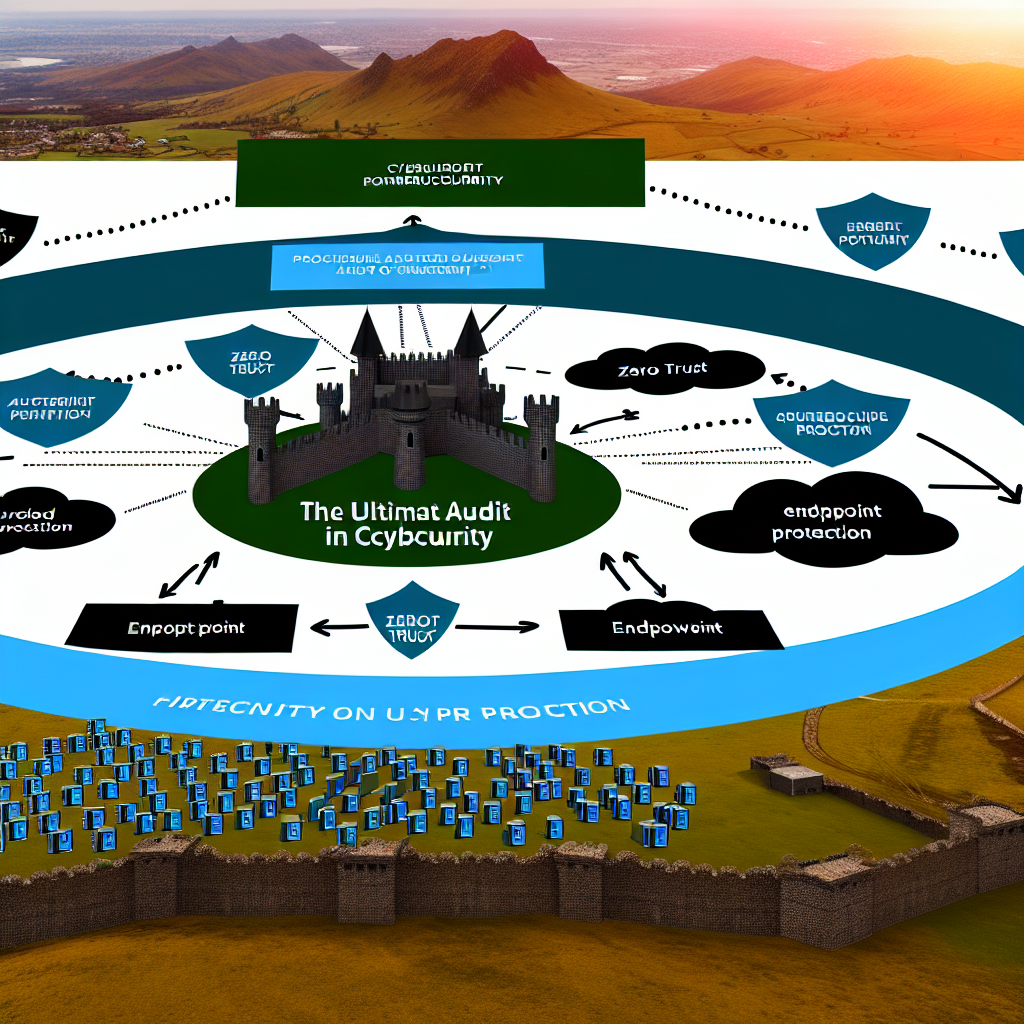Enhancing Endpoint Protection: Key Strategies for Modern IT Security
In the rapidly evolving landscape of information technology, the importance of robust cybersecurity measures cannot be overstated. As organizations increasingly rely on digital infrastructures, the need to protect endpoints—devices such as laptops, smartphones, and servers—becomes paramount. These endpoints often serve as gateways for cyber threats, making them critical focal points in any comprehensive cybersecurity strategy. Consequently, enhancing endpoint protection is a vital component of modern IT security, requiring a multifaceted approach that integrates advanced technologies, strategic planning, and continuous monitoring.
To begin with, the implementation of next-generation antivirus (NGAV) solutions is a fundamental step in bolstering endpoint security. Unlike traditional antivirus software, NGAV employs machine learning and behavioral analysis to detect and neutralize threats in real-time. This proactive approach allows for the identification of previously unknown threats, thereby reducing the risk of successful cyberattacks. By leveraging artificial intelligence, NGAV solutions can adapt to the ever-changing threat landscape, providing a dynamic defense mechanism that evolves alongside emerging cyber threats.
In addition to NGAV, endpoint detection and response (EDR) systems play a crucial role in modern IT security strategies. EDR solutions offer continuous monitoring and analysis of endpoint activities, enabling the rapid detection of suspicious behavior. By providing detailed insights into potential threats, EDR systems facilitate swift incident response, minimizing the impact of security breaches. Furthermore, the integration of EDR with centralized security information and event management (SIEM) systems enhances the overall visibility of an organization’s security posture, allowing for more informed decision-making.
Moreover, the adoption of a zero-trust security model is increasingly recognized as an effective strategy for endpoint protection. This model operates on the principle of “never trust, always verify,” requiring strict identity verification for every user and device attempting to access network resources. By implementing multi-factor authentication (MFA) and least privilege access controls, organizations can significantly reduce the risk of unauthorized access. The zero-trust approach ensures that even if an endpoint is compromised, the potential for lateral movement within the network is minimized, thereby containing the threat.
Another critical aspect of enhancing endpoint protection is the regular conduct of cybersecurity audits. These audits provide a comprehensive assessment of an organization’s security measures, identifying vulnerabilities and areas for improvement. By systematically evaluating endpoint security protocols, organizations can ensure compliance with industry standards and regulations, while also fortifying their defenses against potential threats. Cybersecurity audits serve as a valuable tool for maintaining the integrity of endpoint protection strategies, offering insights that inform future security investments and initiatives.
Furthermore, employee education and awareness are indispensable components of effective endpoint protection. Human error remains a leading cause of security breaches, underscoring the need for ongoing training programs that educate employees about cybersecurity best practices. By fostering a culture of security awareness, organizations can empower their workforce to recognize and respond to potential threats, thereby enhancing the overall resilience of their IT infrastructure.
In conclusion, the protection of endpoints is a critical element of modern IT security strategies. By integrating advanced technologies such as NGAV and EDR, adopting a zero-trust security model, conducting regular cybersecurity audits, and promoting employee education, organizations can significantly enhance their endpoint protection measures. As cyber threats continue to evolve, a proactive and comprehensive approach to endpoint security will be essential in safeguarding digital assets and ensuring the continuity of business operations.
Firewall Setup Best Practices: Strengthening Your Network’s First Line of Defense
In the ever-evolving landscape of cybersecurity, the importance of a robust firewall setup cannot be overstated. As the first line of defense against potential cyber threats, firewalls play a crucial role in safeguarding an organization’s network infrastructure. To ensure optimal protection, it is essential to adhere to best practices when configuring and maintaining these critical security components.
To begin with, understanding the fundamental purpose of a firewall is key. Firewalls act as a barrier between a trusted internal network and untrusted external networks, such as the internet. They monitor and control incoming and outgoing network traffic based on predetermined security rules. By doing so, they help prevent unauthorized access and potential data breaches. Therefore, a well-configured firewall is indispensable for any organization aiming to protect its digital assets.
One of the primary best practices in firewall setup is to define a clear and comprehensive security policy. This policy should outline the specific rules and criteria for allowing or denying network traffic. It is crucial to tailor these rules to the unique needs and risks of the organization. For instance, only necessary services and ports should be open, while all others should be blocked by default. This principle of least privilege ensures that the network is exposed to minimal risk.
Moreover, regular updates and patches are vital to maintaining the effectiveness of a firewall. Cyber threats are constantly evolving, and outdated firewall software can become a vulnerability. By keeping the firewall software up to date, organizations can protect themselves against newly discovered threats and vulnerabilities. Additionally, it is advisable to subscribe to threat intelligence services that provide real-time updates on emerging threats, enabling proactive adjustments to firewall rules.
Another critical aspect of firewall setup is the implementation of network segmentation. By dividing the network into smaller, isolated segments, organizations can limit the spread of potential threats. This approach not only enhances security but also improves network performance by reducing congestion. Firewalls can be configured to control traffic between these segments, ensuring that only authorized communication occurs.
Furthermore, logging and monitoring are essential components of an effective firewall strategy. By enabling logging, organizations can keep track of all network activity, which is invaluable for identifying suspicious behavior and conducting forensic analysis in the event of a security incident. Regularly reviewing these logs allows for the timely detection of anomalies and the adjustment of firewall rules as necessary.
In addition to these technical measures, employee training and awareness are crucial for maintaining a secure network environment. Human error remains one of the leading causes of security breaches. By educating employees about the importance of cybersecurity and the role of firewalls, organizations can foster a culture of vigilance and responsibility. This includes training on recognizing phishing attempts and understanding the implications of bypassing security protocols.
Finally, conducting regular audits and assessments of the firewall setup is imperative. These evaluations help identify potential weaknesses and ensure compliance with industry standards and regulations. By engaging in continuous improvement, organizations can adapt to the dynamic threat landscape and maintain a robust security posture.
In conclusion, a well-configured firewall is a cornerstone of any effective cybersecurity strategy. By adhering to best practices such as defining clear security policies, keeping software updated, implementing network segmentation, and fostering employee awareness, organizations can significantly enhance their network’s first line of defense. As cyber threats continue to grow in sophistication, a proactive and comprehensive approach to firewall management is essential for safeguarding digital assets and ensuring business continuity.
Implementing Zero Trust: A Modern Approach to Cybersecurity
In the rapidly evolving landscape of digital technology, the concept of cybersecurity has become paramount for organizations striving to protect their sensitive data and maintain operational integrity. As cyber threats grow in sophistication and frequency, traditional security models, which often rely on perimeter defenses, are proving inadequate. This has led to the emergence of the Zero Trust model, a modern approach to cybersecurity that fundamentally shifts how organizations think about and implement security measures.
Zero Trust is predicated on the principle of “never trust, always verify.” Unlike traditional models that assume everything inside an organization’s network can be trusted, Zero Trust operates on the assumption that threats could exist both outside and inside the network. This approach requires that every request to access resources be authenticated, authorized, and encrypted, regardless of its origin. By doing so, Zero Trust minimizes the risk of unauthorized access and data breaches, even if a malicious actor manages to penetrate the network perimeter.
Implementing a Zero Trust architecture involves several key components. First, organizations must establish strict identity verification processes. This means employing multi-factor authentication (MFA) and ensuring that users are who they claim to be before granting access to any resources. Additionally, the principle of least privilege should be enforced, granting users the minimum level of access necessary to perform their duties. This reduces the potential damage that could be caused by compromised credentials.
Moreover, Zero Trust requires continuous monitoring and validation of user activities. By leveraging advanced analytics and machine learning, organizations can detect anomalies and potential threats in real-time. This proactive approach allows for swift responses to suspicious activities, thereby mitigating potential security incidents before they escalate.
Another critical aspect of Zero Trust is the segmentation of networks. By dividing the network into smaller, isolated segments, organizations can contain breaches and prevent lateral movement by attackers. This segmentation ensures that even if one segment is compromised, the attacker cannot easily access other parts of the network.
Transitioning to a Zero Trust model also necessitates a cultural shift within organizations. It requires collaboration between IT, security teams, and business units to ensure that security measures align with organizational goals without hindering productivity. This cultural change is supported by comprehensive training programs that educate employees about the importance of cybersecurity and their role in maintaining a secure environment.
Furthermore, the adoption of Zero Trust is facilitated by modern IT strategies that leverage cloud computing and virtualization. These technologies provide the flexibility and scalability needed to implement Zero Trust principles effectively. Cloud-based solutions, for instance, offer advanced security features and enable organizations to apply consistent security policies across diverse environments.
In conclusion, as cyber threats continue to evolve, the Zero Trust model represents a robust and adaptive approach to cybersecurity. By focusing on identity verification, continuous monitoring, network segmentation, and cultural alignment, organizations can significantly enhance their security posture. While the transition to Zero Trust may require substantial effort and investment, the long-term benefits of a more secure and resilient IT infrastructure are undeniable. As such, organizations that embrace Zero Trust are better positioned to protect their assets and maintain trust with their stakeholders in an increasingly digital world.
Network Intrusion Detection: Techniques for Identifying and Mitigating Threats
In the ever-evolving landscape of cybersecurity, network intrusion detection has become a critical component of modern IT strategies. As organizations increasingly rely on digital infrastructures, the need to protect sensitive data from unauthorized access has never been more pressing. Network intrusion detection systems (NIDS) play a pivotal role in identifying and mitigating potential threats, ensuring that networks remain secure and resilient against cyberattacks. By employing a combination of techniques, these systems can effectively detect anomalies and prevent breaches before they cause significant damage.
One of the primary techniques used in network intrusion detection is signature-based detection. This method involves comparing network traffic against a database of known threat signatures. When a match is found, the system alerts administrators to the potential intrusion. Signature-based detection is highly effective for identifying known threats, as it relies on a comprehensive library of attack patterns. However, it is important to note that this approach may struggle to detect new or unknown threats, as it can only identify attacks that have been previously cataloged.
To address the limitations of signature-based detection, anomaly-based detection techniques have been developed. These methods focus on identifying deviations from normal network behavior. By establishing a baseline of typical network activity, anomaly-based systems can detect unusual patterns that may indicate a potential intrusion. This approach is particularly useful for identifying zero-day attacks and other novel threats that do not yet have known signatures. Nevertheless, anomaly-based detection can sometimes result in false positives, as legitimate changes in network behavior may be mistakenly flagged as threats.
In addition to these traditional techniques, machine learning and artificial intelligence (AI) are increasingly being integrated into network intrusion detection systems. By leveraging advanced algorithms, these technologies can analyze vast amounts of data to identify complex patterns and correlations that may indicate a security threat. Machine learning models can be trained to recognize both known and unknown threats, improving the accuracy and efficiency of intrusion detection. Furthermore, AI-driven systems can adapt to evolving threats, continuously updating their detection capabilities to stay ahead of cybercriminals.
While detection is a crucial aspect of network security, it is equally important to have effective mitigation strategies in place. Once a potential threat is identified, organizations must act swiftly to contain and neutralize it. This often involves isolating affected systems, blocking malicious traffic, and implementing patches or updates to address vulnerabilities. Additionally, comprehensive incident response plans should be established to guide organizations through the process of managing and recovering from a security breach.
Moreover, regular cybersecurity audits are essential for maintaining robust network security. These audits help organizations identify weaknesses in their defenses and ensure that their intrusion detection systems are functioning optimally. By conducting thorough assessments of their IT infrastructure, organizations can proactively address potential vulnerabilities and enhance their overall security posture.
In conclusion, network intrusion detection is a vital component of modern cybersecurity strategies. By employing a combination of signature-based, anomaly-based, and AI-driven techniques, organizations can effectively identify and mitigate potential threats. However, detection alone is not enough; robust mitigation strategies and regular cybersecurity audits are also necessary to ensure comprehensive protection. As cyber threats continue to evolve, staying informed about the latest advancements in intrusion detection and response will be crucial for safeguarding sensitive data and maintaining the integrity of digital infrastructures.
Conducting a Comprehensive Cybersecurity Audit: Ensuring IT Compliance and Threat Detection
In today’s rapidly evolving digital landscape, the importance of conducting a comprehensive cybersecurity audit cannot be overstated. As organizations increasingly rely on technology to drive their operations, the need to ensure IT compliance and enhance threat detection capabilities becomes paramount. A cybersecurity audit serves as a critical tool in this endeavor, providing a systematic evaluation of an organization’s information systems, policies, and procedures. By identifying vulnerabilities and assessing the effectiveness of existing security measures, a cybersecurity audit helps organizations safeguard their digital assets and maintain the trust of their stakeholders.
To begin with, a cybersecurity audit involves a thorough examination of an organization’s IT infrastructure. This includes evaluating hardware, software, networks, and data management practices to ensure they align with industry standards and regulatory requirements. By doing so, organizations can identify potential weaknesses that could be exploited by cybercriminals. Moreover, the audit process helps in verifying that security controls are functioning as intended, thereby reducing the risk of data breaches and other cyber threats.
In addition to assessing technical aspects, a comprehensive cybersecurity audit also examines an organization’s policies and procedures. This involves reviewing security policies, incident response plans, and employee training programs to ensure they are up-to-date and effective. By evaluating these components, organizations can identify gaps in their security posture and implement necessary improvements. Furthermore, a well-conducted audit can reveal areas where additional training or resources may be needed to enhance the overall security culture within the organization.
Transitioning from the assessment phase, the next step in a cybersecurity audit is to analyze the findings and develop a strategic plan for remediation. This involves prioritizing identified risks based on their potential impact and likelihood of occurrence. By adopting a risk-based approach, organizations can allocate resources more effectively and address the most critical vulnerabilities first. Additionally, this phase of the audit provides an opportunity to align cybersecurity efforts with broader business objectives, ensuring that security measures support the organization’s strategic goals.
Moreover, a cybersecurity audit is not a one-time event but rather an ongoing process. As technology continues to evolve and cyber threats become more sophisticated, organizations must regularly reassess their security posture to stay ahead of potential risks. This requires a commitment to continuous improvement and adaptation, as well as a proactive approach to threat detection and response. By conducting regular audits, organizations can ensure that their cybersecurity strategies remain effective and resilient in the face of emerging challenges.
In conclusion, conducting a comprehensive cybersecurity audit is an essential component of modern IT strategies. By systematically evaluating an organization’s information systems, policies, and procedures, a cybersecurity audit helps ensure IT compliance and enhance threat detection capabilities. Through this process, organizations can identify vulnerabilities, prioritize risks, and implement necessary improvements to safeguard their digital assets. Furthermore, by adopting a proactive and continuous approach to cybersecurity, organizations can maintain the trust of their stakeholders and support their long-term business objectives. As the digital landscape continues to evolve, the importance of cybersecurity audits will only grow, making them an indispensable tool for organizations seeking to navigate the complexities of the modern IT environment.
Enhance your organization’s security posture with expert insights on cybersecurity audits and modern IT strategies. Discover more at Comptss.











